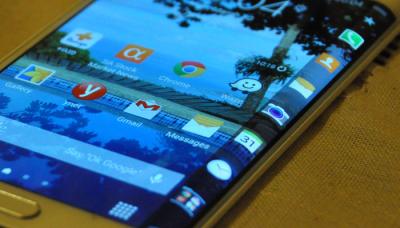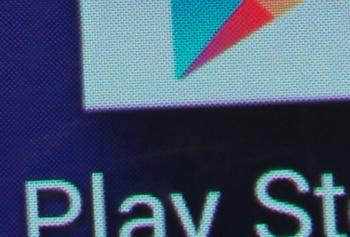Super AMOLED: introduction and market status
OLED displays use organic materials that emit light when electricity is applied. OLEDs enable emissive, bright, thin, flexible and efficient displays. OLEDs are replacing LCDs in most display applications - from smartphones and wearables to monitors and TVs.

Samsung's Super AMOLED displays, announced in 2010, are AMOLED displays for mobile devices (such as smartphones, wearables and tablets) with an integrated touch function. The thickness of the touch sensor is just 0.001 mm and this allows the screen to provide better images and to have great visibility even in direct sunlight compared with regular AMOLED displays with an external touch layer.
Samsung is producing hundreds of millions of Super AMOLED displays today, used mostly in smartphones, but also in other devices. These are considered to be some of the best displays on the market.
Super AMOLED and the Pentile matrix
Samsung's Super AMOLED displays use a Pentile matrix sub-pixel design. That means that the green sub-pixel is shared by two pixels and the display has only 2 sub-pixels per real 'pixel' compared to the classic RGB matrix design (or Real-Stripe). You can see a PenTile matrix vs a Real-Stripe one on the images below (the PenTile is on the right). Newer Super AMOLED displays use a different PenTile matrix (Diamond Pixel pattern).
Super AMOLED vs Dynamic AMOLED
In 2019 Samsung introduced its next-generation mobile display technology, which it calls Dynamic AMOLED. Basically a Dynamic AMOLED is similar to a Super AMOLED display, but it adds HDR support. Samsung's highest end smartphones adopt the company's Dynamic AMOLED 2X LTPO AMOLED displays.
Further reading
- Introduction to OLEDs
- Samsung's OLED displays
- Pentile Technology explained
- Flexible OLEDs
- OLED mobile phones
- The OLED Toolbox: a one-stop-shop for OLED information, insights, analysis and guides
DisplayMate: the Galaxy Note 3 has the best performing OLED display ever, beats LCDs across the board
DisplayMate, the display testing, measurement and calibration experts just got their hands on a pre-release Galaxy Note 3 production unit, with its 5.7" Full-HD Super AMOLED display (386 PPI, PenTile). They put the unit to extensive testing (and also compared it to the Note 2). The conclusion? This is the best performing OLED display ever and it beats LCDs across the board!

The most notable advancement in this new panel is the high brightness. It can achieve 660 cd/m2 in high ambient light. It's not just 55% brighter than the Note 2, it's actually the brightest display ever tested at DisplayMate. A very notable achievement for Samsung's OLEDs, which were lagging behind LCDs in brightness.
IFA 2013 - OLED summary
So the IFA 2013 event is now over - and there has been a lot of interesting OLED TVs on display, so I thought I'd post a short summary post. The most impressive OLED TV was probably LG's 77" curved UHD (4K) WRGB one. I don't think this huge OLED panel will enter production soon, but it was still an impressive feat and it's the world's largest OLED panel ever. LG also showed their new flat-panel Gallery OLED TV.
 LG 77-inch curved OLED TV prototype
LG 77-inch curved OLED TV prototype
Samsung also unveiled 4K OLEDs - one curved and one flat. These were smaller at 55", and Samsung says this is just a "proof of concept". Samsung had curved LCDs on display as well, 55" and 65" in size and both offering 4K resolution. Sony also unveiled a curved LCD: the S990A curved LED-backlit LCD. Sony's panel is 65" in size and only offers Full-HD, but it is closer to market (they are accepting pre-orders now for $4,000) and it features the color-enhancing Triluminos display technology (QDVision's Quantum-Dot films).
Speculation on the Galaxy Note 3 sub-pixel arrangement
When Samsung unveiled the Galaxy Note 3 they said it's got a 5.7" Full-HD Super AMOLED display (386 PPI) - but they didn't reveal what is the sub-pixel arrangement. Some sites say it is a Pentile display while other say it not.
 Galaxy Note 3 display up close
Galaxy Note 3 display up close
According to Chinese site RBMen, the Note 3 uses a Diamond Pixel architecture - similarly to the Galaxy S4. Diamond Pixel is indeed a PenTile subpixel scheme, and there are twice as many green subpixels as there are blue and red ones. The green subpixels are oval and small while the red and blue ones are diamond-shaped and larger. So perhaps both reports are right: it is indeed a PenTile display, but not a regular one...
Samsung launches the Note 3 and the Galaxy Gear smartwatch, both with Super AMOLED dipslays
As expected, Samsung launched two new mobile devices today with Super AMOLED displays. First up is the Galaxy Note 3 that sports a 5.7" Full-HD Super AMOLED display (386 PPI), a 2.3 Quad-Core CPU (or a 1.9Ghz octa-core in some markets), 3 GB of RAM, 32/64GB of storage, a 13 MP camera (will be capable of 4K videos in some markets) and Android 4.3. Samsung managed to pack all this in a phone that is smaller and lighter than the Note 2.

The Galaxy Gear is Samsung's first smartwatch and it features a 1.63" 320x320 (275 PPI) Super AMOLED display, a 1.9 mp camera (can do 720p videos), 800Mhz processor, 4GB of storage, 512MB of RAM, Bluetooth 4, and a 315 mAh non-removeable battery. The watch will support third-party apps and 70 partners signed up to supply applications at launch.
Samsung's Q2 results disappoint due to slow GS4 sales
Samsung reported their preliminary financial results for Q2 2013. While they posted a record operating profit (over $8 billion, up 47% compared to Q2 2012), they missed analysts estimates, mostly due to disappointing GS4 sales.

According to reports, Samsung already sold 20 million GS4s in just over two months - about 70% faster than the GS3. But still analysts expected more. Hopefully when Samsung actually reports the final results, they'll comment on the GS4 sales. Samsung plans to sell 100 million units of their flagship smartphone.
Samsung sold 20 million GS4 phones, in just over 2 months
Samsung launched the GS4 towards the end of May. They sold 10 million units in less than a month, and now Korean media report that sales reached the 20 million mark - in just over two months. Even though sales have reportedly slowed down, the GS4 is still selling about 70% faster than the GS3.

Samsung still plans to sell 100 million units of the GS4. Samsung's flagship phone features a 4.99" Full-HD (1920x1280, 441 PPI) Super AMOLED display, an Octa-core (Quadcore in some models) 1.6Ghz CPU, 2GB of memory, 13 mp camera and a 2,600 mAh battery. The GS4 includes a lot of new software features and special UI controls, include the Adapt Display which allows extensive display calibration adjustments.
The Galaxy Note 3 - so will it sport a plastic-based AMOLED display?
Two days ago we reported on new rumors from Korea saying that Samsung will have to use IPS-LCD displays in about 10% of the Note 3 phones due to expected AMOLED production shortages. Today MT Media (a Korean publication) posted an "Exclusive" article in which they say that Samsung will in fact use a plastic-based unbreakable 5.99" YOUM OLED display in the Note 3.
 YOUM phone prototype, CES 2013
YOUM phone prototype, CES 2013
This coincides with the OLED Association claim back in April that the Note 3 phone will use a YOUM display. Samsung's YOUM capacity (especially for these relatively large 5.99" panels) will be quite limited at first, but it seems that Samsung really has to innovate in their new phones. The GS4 is a great phone with a terrific display, but it isn't really innovative in hardware or design (and some suggest that sales aren't as good as Samsung hoped for).
Samsung to use LCD in some Note 3 phones due to AMOLED shortage?
A new report from Korea suggests that Samsung will use IPS-LCD displays in some Note 3 models. The Korean company aims to have about 10% of the Note 3 phones use LCD displays. The rest will use Super AMOLED displays. Apparently Samsung will buy those LCD displays from Sharp (Samsung owns about 3% of the troubled display maker following a recent investment).
 Galaxy Note II
Galaxy Note II
The main reason the report gives for this decision is that Samsung may have an AMOLED supply issue. Earlier this month DisplaySearch estimated that AMOLED supply/demand ratio will fall to 1% in Q4 2013 - basically saying that supply will be very tight with a good chance shortages. So perhaps Samsung is working on a backup plan by designing models with LCDs instead of AMOLEDs.
Analysts say GS4 orders slowing down
Samsung sold 10 million GS4 phones in less than a month, and the GS4 was Samsung's fastest selling phone. But now analysts claim that orders are slowing down, and Samsung lowered its monthly supply orders to 7-8 million units down from 10 million. They say that demand in Korea and Europe is "weak".

Samsung recently launched new "mid-range" phones (such as the GS4 mini) and this may be cannibalizing flagship smartphone sales. Samsung originally hoped to sell over 100 million GS4 units, perhaps they were too optimistic. - or double the GS3 sales. The GS4 is currently available in more than 110 countries and will be rolled out to a total of 155 countries soon.
Verizon to ship the Blackberry Q10 on June 6, accepts pre-orders
Verizon is now accepting pre-orders for the Blackberry Q10, with its square 3.2" 720x720 (330 ppi) Super AMOLED display. The Q10 costs $200 with a two-year contract, or $600 unlocked. Verizon will ship this phone on June 6.

Other Q10 features include a hardware keyboard, LTE, 1.5Ghz dual-core CPU and 2GB of RAM. This is Blackberry's first hardware keyboard device to sport the company's new BB10 OS.
Pagination
- Previous page
- Page 10
- Next page

